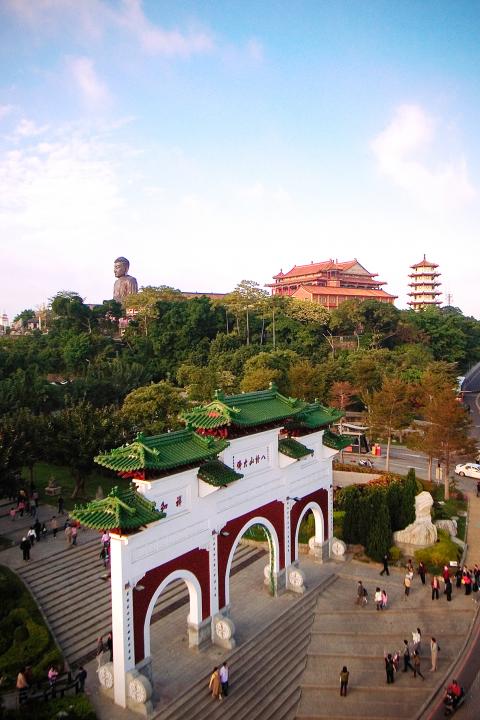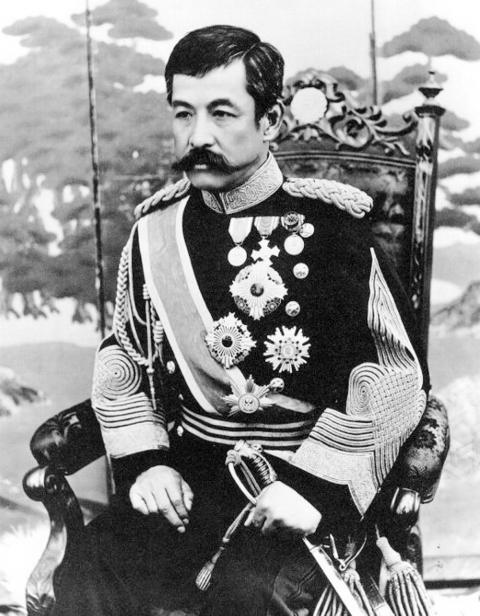Aug. 29 to Sept. 4
After landing in Taiwan and encountering much local resistance, the Japanese army reached the northern banks of the Dadu River (大肚溪), on what is today’s border between Taichung and Changhua County, on Aug. 25, 1895. They did not cross the river immediately, as the enemy had regrouped on the south banks in the city of Changhua and on the nearby battery on Baguashan (八卦山).
After a few days of scouting and minor skirmishes, the Japanese army of about 15,000 men split into two wings, with the left wing crossing the river in the dark on Aug. 27. They attacked the battery in the morning, and thus began the Battle of Baguashan (八卦山之役), the largest clash between the two sides.

Photo courtesy of Wikimedia Commons
On May 25, 1895, about a month after the Qing Empire ceded Taiwan to Japan, Qing officials and the Taiwanese elite established the Republic of Formosa (台灣民主國) in a bid to resist the transfer of Taiwan to Japan.
In the June 19 edition of Taiwan in Time, we examined the legacy of the resistance leaders who ran away upon defeat: republic president Tang Ching-sung (唐景崧), who fled to China after Keelung was captured, and vice president Chiu Feng-chia (丘逢甲), who did the same after the fall of Taipei. And finally Liu Yong-fu (劉永福), who jumped ship two days before the Japanese entered his stronghold of Tainan.
This week, we will remember those who stayed and fought to the death. After Chiu’s departure, Liu assumed leadership of the resistance. But his Black Flag Army remained stationed in Tainan, and someone needed to step up and stop the Japanese from moving south from Taipei.

Photo courtesy of Wikimedia Commons
HAKKA MILITIAS
Wu Tang-hsing (吳湯興), a Hakka from Miaoli, took on the task as he organized a militia comprised of fellow Hakka from the area and swore to defend their homeland to the death. Wu was later joined by Chiang Shao-tzu (姜紹祖) and Hsu Hsiang (徐驤), also Hakka who had recruited their own armies.
All three were scholars who had passed the imperial examinations, and it is said that Chiang was no more than 20 years old. The trio earned many monikers, and Chen Wen-teh (陳文德) refers to them in his book, Showdown at Bagua Mountain (決戰八卦山) as the “Three Hakka Musketeers (客家三劍客).”
Chen writes that this was not a formal army, and “the leaders’ command was not absolute,” as the units “often acted individually during battle, rarely being able to focus all their efforts on resisting the Japanese … Even though they did cause the Japanese a lot of trouble, their actual accomplishments were limited.”
This army first clashed with the Japanese in northern Hsinchu. Wu personally led the resistance, driving away the enemy twice. But soon, the Japanese regrouped and decided to charge at full force, capturing Hsinchu a week later despite the Hakka army’s guerrilla tactics.
Chiang was captured in an attempt to retake Hsinchu, and he reportedly committed suicide by ingesting opium. As the Hakka militia retreated to Miaoli, they were joined by Wu Peng-nian (吳彭年) of the Black Flag Army. Wu Peng-nian was not a native of Taiwan, having arrived as Liu’s top aide, but Chen writes that he had decided to defend Taiwan at all cost.
THE DECISIVE BATTLE
After much fierce fighting, the Japanese captured Taichung, and the resistance regrouped in Changhua with between 3,000 and 5,000 troops, comprised of surviving members of the Hakka militia, Black Flag Army and remaining Qing troops.
The Japanese army’s right wing remained on the north bank, lighting camp fires and firing cannons to divert the resistance’s attention while the left wing had arrived unnoticed at the foot of Baguashan, which was guarded by Wu Tang-hsing’s unit and soon joined by Hsu’s.
The resistance fired their cannons at the advancing enemy to no avail, and an intense battle ensued between the two sides. Meanwhile, the Japanese right wing had crossed the river and engaged with the Black Flag Army.
Unable to withstand the Japanese army’s superior artillery, Wu Tang-hsing was killed here while Hsu managed to break out of the siege. Upon seeing the Japanese flag raised on Baguashan, Wu Peng-nian rushed to reclaim the battery and also died in the effort. The Japanese took Changhua easily after that, and continued their push south.
Hsu continued to fight after this campaign, and died near Douliou (斗六) in Yunlin County, the last of the musketeers to fall.
Taiwan in Time, a column about Taiwan’s history that is published every Sunday, spotlights important or interesting events around the nation that have anniversaries this week.

April 14 to April 20 In March 1947, Sising Katadrepan urged the government to drop the “high mountain people” (高山族) designation for Indigenous Taiwanese and refer to them as “Taiwan people” (台灣族). He considered the term derogatory, arguing that it made them sound like animals. The Taiwan Provincial Government agreed to stop using the term, stating that Indigenous Taiwanese suffered all sorts of discrimination and oppression under the Japanese and were forced to live in the mountains as outsiders to society. Now, under the new regime, they would be seen as equals, thus they should be henceforth

Last week, the the National Immigration Agency (NIA) told the legislature that more than 10,000 naturalized Taiwanese citizens from the People’s Republic of China (PRC) risked having their citizenship revoked if they failed to provide proof that they had renounced their Chinese household registration within the next three months. Renunciation is required under the Act Governing Relations Between the People of the Taiwan Area and the Mainland Area (臺灣地區與大陸地區人民關係條例), as amended in 2004, though it was only a legal requirement after 2000. Prior to that, it had been only an administrative requirement since the Nationality Act (國籍法) was established in

With over 80 works on display, this is Louise Bourgeois’ first solo show in Taiwan. Visitors are invited to traverse her world of love and hate, vengeance and acceptance, trauma and reconciliation. Dominating the entrance, the nine-foot-tall Crouching Spider (2003) greets visitors. The creature looms behind the glass facade, symbolic protector and gatekeeper to the intimate journey ahead. Bourgeois, best known for her giant spider sculptures, is one of the most influential artist of the twentieth century. Blending vulnerability and defiance through themes of sexuality, trauma and identity, her work reshaped the landscape of contemporary art with fearless honesty. “People are influenced by

Three big changes have transformed the landscape of Taiwan’s local patronage factions: Increasing Democratic Progressive Party (DPP) involvement, rising new factions and the Chinese Nationalist Party’s (KMT) significantly weakened control. GREEN FACTIONS It is said that “south of the Zhuoshui River (濁水溪), there is no blue-green divide,” meaning that from Yunlin County south there is no difference between KMT and DPP politicians. This is not always true, but there is more than a grain of truth to it. Traditionally, DPP factions are viewed as national entities, with their primary function to secure plum positions in the party and government. This is not unusual